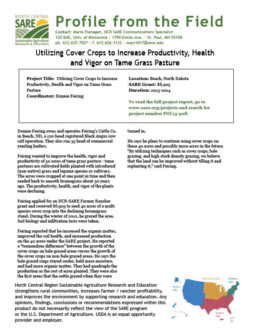Donnie Feiring owns and operates Feiring’s Cattle Co. in Beach, ND, a 120-head registered Black Angus cow calf operation. They also run 35 head of commercial yearling heifers.
Feiring wanted to improve the health, vigor and productivity of 50 acres of tame grass pasture - tame pastures are cultivated fields planted with introduced (non-native) grass and legume species or cultivars. The acres were cropped at one point in time and then seeded back to smooth bromegrass about 30 years ago. The productivity, health, and vigor of the plants were declining.
Feiring applied for an NCR-SARE Farmer Rancher grant and received $6,905 to seed 40 acres of a multi species cover crop into the declining bromegrass stand. During the winter of 2012, he grazed the area. Soil biology and infiltration tests were taken.
Feiring reported that he increased the organic matter, improved the soil health, and increased production on the 40 acres under the SARE project. He reported a “tremendous difference” between the growth of the cover crops on bale grazed areas versus the growth of the cover crops on non-bale grazed areas. He says the bale grazed rings stayed cooler, held more moisture, and had more organic matter. They had quadruple the production as the rest of acres planted. They were also the first areas that the cattle grazed when they were turned in.
He says he plans to continue using cover crops on these 40 acres and possibly more acres in the future.
“By utilizing techniques such as cover crops, bale grazing, and high stock density grazing, we believe that the land can be improved without tilling it and replanting it,” said Feiring.
